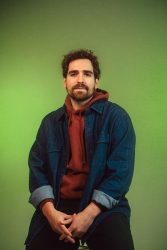
Moonlite Labs founder and CEO Adam Fainman.
Photo by Josh Kirschner.
Recently, Winnipegger Adam Fainman launched Moonlite Labs, a generative artificial intelligence (AI) platform for content creators to produce images, videos and animations with minimal technical expertise.
In addition, users can edit the generated clips on the platform and export them in different aspect ratios. Fainman also revealed that the team will soon add a scheduling function where users can post generated content across multiple platforms.
Fainman has a background in computer science, psychology and digital media design, culminating in a master’s degree in music technology at the University of Toronto. He also works as a musician under the name Beatox.
“I love the intersection of tech and creativity, and that’s [why] I founded and created Moonlite Labs, which was a solution and tool for, ideally, artists and creatives to create visuals for digital storytelling [by] leveraging generative AI tech,” Fainman explained.
Moonlite Labs has gained considerable traction. This year, Fainman travelled to Europe to showcase his platform in VivaTech, a large technology conference that takes place in Paris. According to Moonlite Labs’ website, it has also received funding from the provincial government and National Research Council of Canada.
However, the use of AI in the arts is mired in endless controversy. For example, some argue that AI lacks the personal touch that only a human with lived experience can have, resulting in art devoid of soul and emotion.
AI in social media can be equally as problematic — most internet users have probably encountered “AI slop” or low-quality AI-generated content at some point. Photos of “Shrimp Jesus” or a car made of plastic bottles might be cringeworthy, but danger looms when people mistake generated photos as genuine.
Other critics are concerned with the ethics of AI art. AI uses existing images and videos on the internet to generate content, but this can happen without the original artists’ consent. Fainman stated that in the future, he hopes to see artists getting paid to use their work to train AI models.
“I think just being able to leverage their creativity and original work with these tools, and training these tools, and getting paid […] would be really neat.”
Fainman also pointed out the technology can be an option for small creators who cannot hire large, expensive teams of artists and producers.
“The goal of [Moonlight Labs] was to give the artists and independent creators a chance to help democratize content creation and even the playing field,” said Fainman.
“A lot of artists, small businesses, independent creators […] don’t maybe have tens of thousands of dollars of budget to [hire] big studios and big teams, but their stories, I believe, should still be told, and they should still have access to multimedia creation.”
However, constraints in ability and technology drive human ingenuity, especially in the music industry. The music video for Lana Del Rey’s “Video Games” is one such example, with shaky handheld video clips and grainy footage highlighting the human effort behind the art. Dada artist Marcel Duchamp revolutionized art by submitting a urinal as a sculpture to a gallery, raising important questions about the nature of art. Perhaps an original and daring idea is what truly drives impactful content, as opposed to the reconstitution of existing works.
With both fervent advocates and opposers, the future of AI in the creative industry is uncertain. Only time will tell if future generations of creatives will look back and see generative AI as a trailblazing tool or a blight on human creativity.

